Key takeaways:
- Student assessments should be varied and reflective, creating opportunities for dialogue to reduce anxiety and foster understanding.
- Effective assessments enhance teacher-student relationships and empower students by allowing them to express their knowledge creatively.
- Feedback is crucial; timely and constructive comments can significantly improve student motivation and engagement.
- Adapting assessment methods based on analysis can lead to more effective teaching practices and better student outcomes.
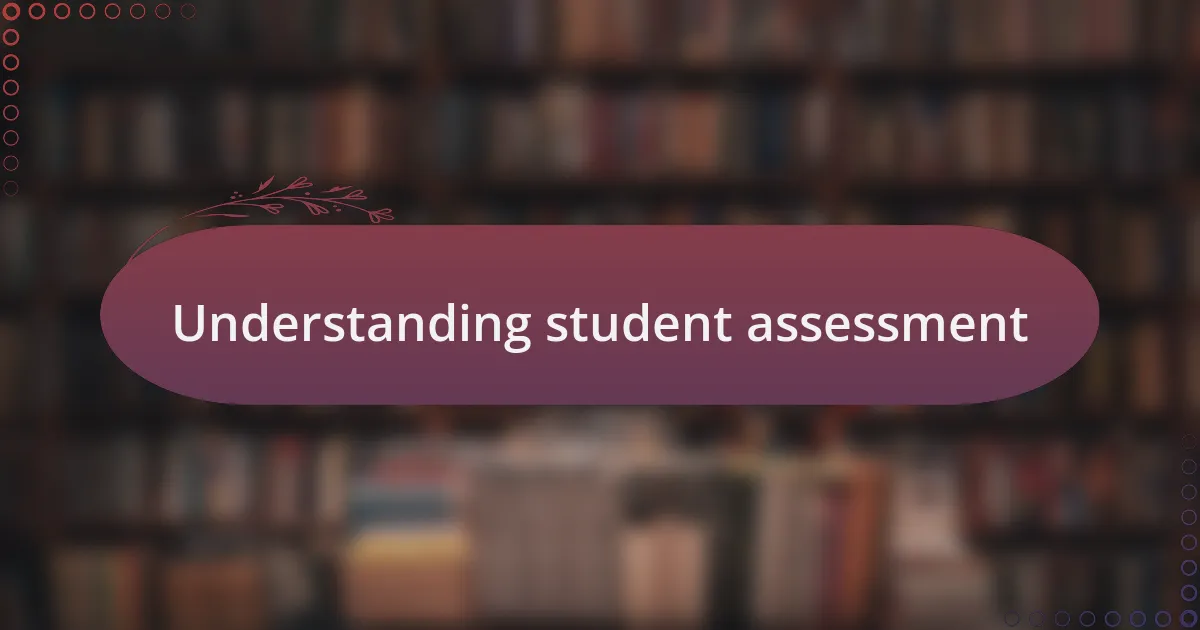
Understanding student assessment
Understanding student assessment goes beyond just grades; it includes the entire process of measuring a student’s progress and understanding. I remember when I first started teaching, I believed that a single test could encapsulate a student’s abilities, but I soon learned that assessments come in many forms. Have you ever felt the pressure of a looming exam? That stress can cloud a student’s true potential and understanding.
As I gained experience, I started seeing assessments as opportunities for dialogue rather than judgment. I recall an instance where I introduced formative assessments—short quizzes and peer reviews—that invited students to share their thoughts. It was enlightening; not only did it ease their anxiety, but it also uncovered insights into their learning processes. Isn’t it fascinating how assessment can actually foster a more supportive learning environment?
Moreover, I’ve realized that student assessment should be reflective and adaptive. For example, I once adjusted my teaching methods after observing patterns in students’ responses; it was a game changer. This adaptability encourages growth rather than just conformity to a standard. How often do we consider the impact of our assessment strategies on students’ motivation and engagement? It’s something worth pondering deeply.
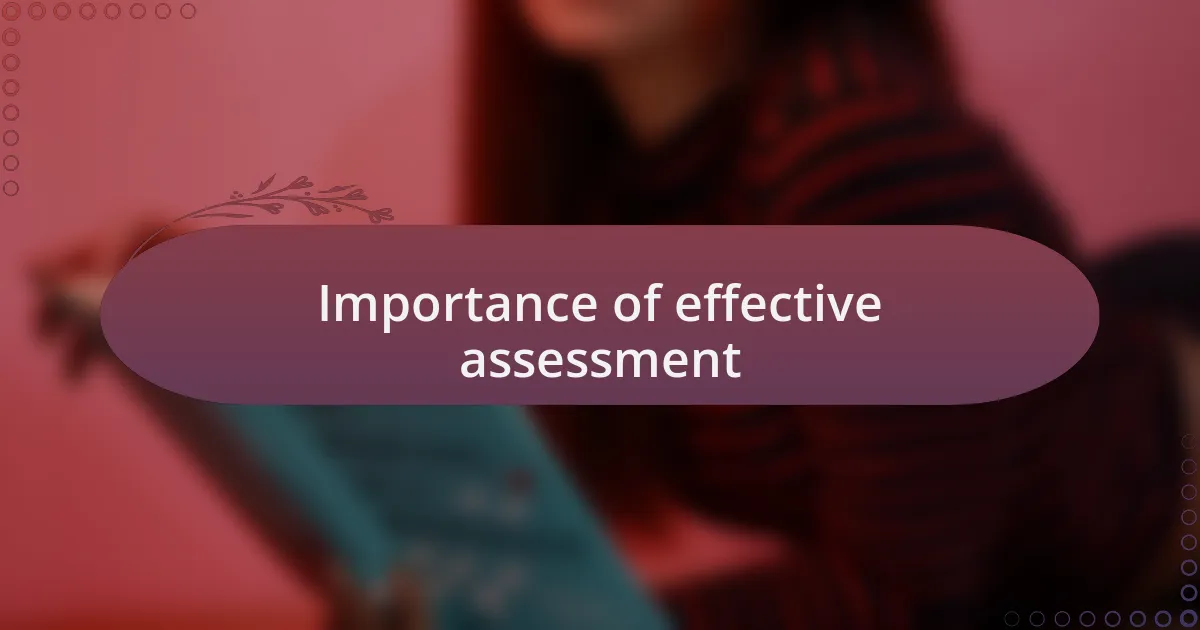
Importance of effective assessment
Effective assessment is crucial because it directly impacts student learning outcomes. I remember when I assessed my students through various methods—like projects and presentations. I quickly saw how these more personalized formats revealed deeper understanding than a standard test ever could. It’s a reminder that the way we assess can empower students to express their knowledge creatively.
In my experience, effective assessment can illuminate not just what students know but also how they think. One time, during a reflective assessment session, I asked students to journal their learning experiences throughout the term. The insights they shared about their struggles and triumphs were eye-opening. Have you ever experienced that moment when a student’s reflection gives you clarity about their learning journey? It’s powerful to witness their growth through their own words.
Moreover, I’ve come to appreciate that effective assessment fosters a stronger teacher-student relationship. Just last semester, I implemented regular feedback sessions, inviting students to discuss their progress candidly. These conversations built trust and encouraged them to take ownership of their learning. Isn’t it remarkable how assessment can bridge the gap between student and educator? The right assessment strategies truly engage students in their educational path.
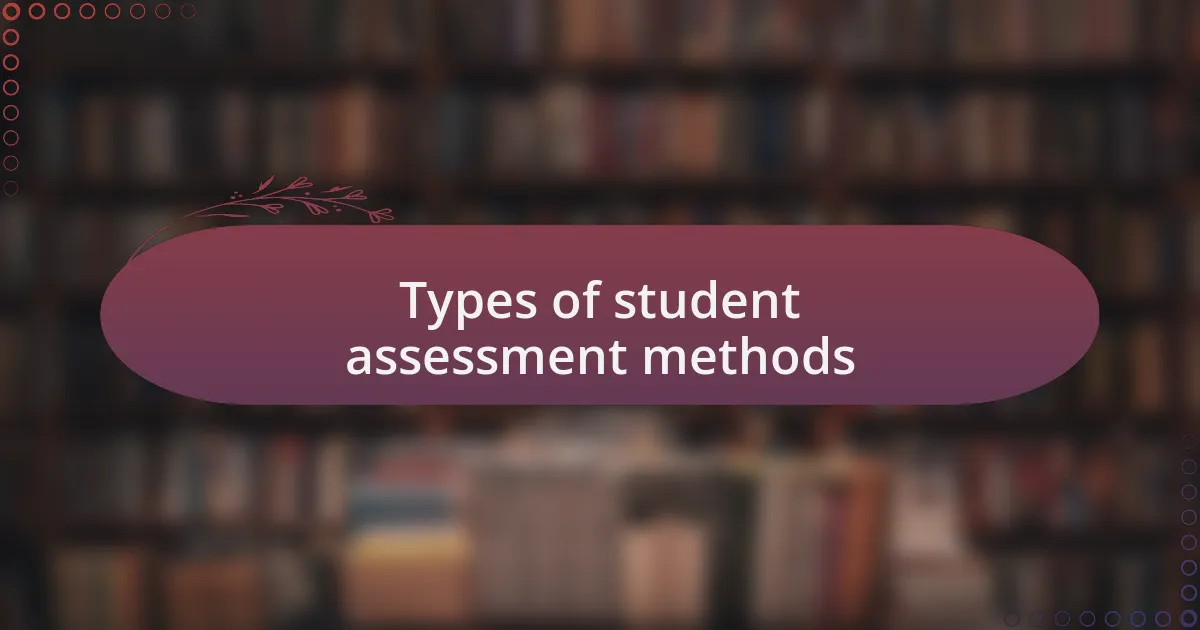
Types of student assessment methods
When it comes to student assessment methods, one of the most commonly used is formative assessment. I often implement quizzes and in-class activities to gauge understanding in real-time. Once, while using a quick exit ticket strategy, I discovered that a significant number of my students struggled with a particular concept. That sharp realization allowed me to pivot my lesson plans immediately and address their needs before moving on.
Another assessment method I frequently utilize is summative assessment, which typically occurs at the end of a unit or course. These formal evaluations, like final exams or large projects, provide a comprehensive picture of how well students have grasped the material. I still remember a scenario where a student who initially struggled with the content soared during our final project presentation. Witnessing that transformation was incredibly fulfilling, and it reinforced my belief in the importance of both types of assessments throughout the learning process.
I’ve also found that alternative assessments, such as portfolios and peer assessments, can be incredibly valuable. When students curate their work over time, it tells a powerful story of their growth and achievements. One particular student’s portfolio, filled with various artifacts, was so reflective of their learning journey that it brought tears to my eyes. How often do we get to see a holistic view of a student’s progress, not just isolated scores? It’s these alternative methods that often shine a light on the unique paths students take in their education.
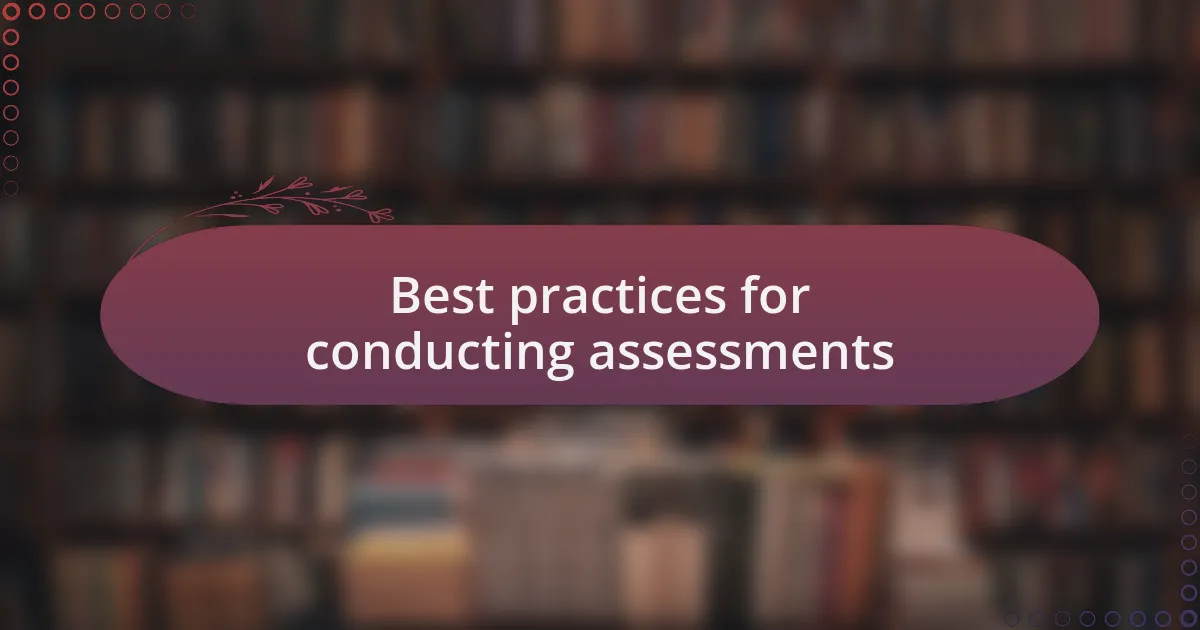
Best practices for conducting assessments
When conducting assessments, it’s crucial to establish clear objectives. I remember vividly a time when I misaligned my assessment questions with the learning goals, leading to confusion among my students. They weren’t evaluated on what I truly intended them to learn, which not only affected their performance but also my own teaching effectiveness. Setting those clear benchmarks helps both students and educators stay on the same page and fosters a purposeful learning environment.
Another best practice is providing timely and constructive feedback. I can’t stress enough how impactful it can be. After administering a midterm, I made it a point to return their papers with detailed comments within a week. The responses I received were overwhelmingly positive; students appreciated having their strengths highlighted alongside areas for improvement. Isn’t it fascinating how a few comments can motivate a student to dive deeper into their learning journey?
Lastly, it’s essential to create a comfortable assessment environment. I once held a math assessment in a more relaxed setting, complete with soft music and flexible seating. The difference was palpable; students felt less anxious and performed better. This experience taught me that the atmosphere around assessment can significantly influence outcomes. How often do we overlook simple changes that can dramatically enhance student experiences?
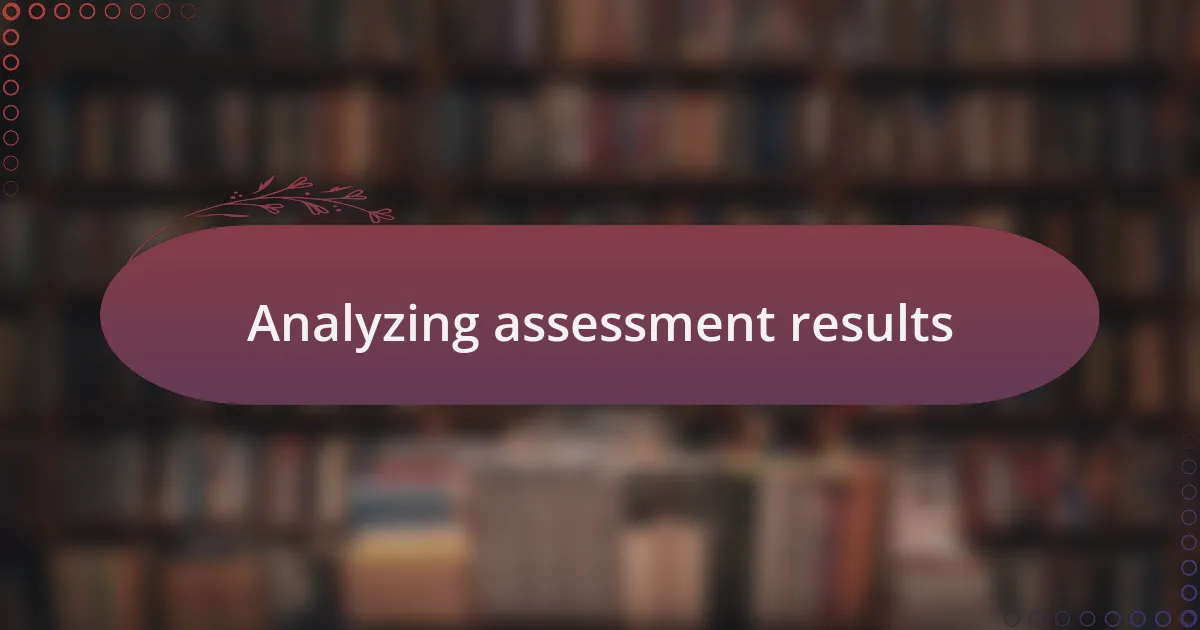
Analyzing assessment results
When I first started analyzing assessment results, I approached it with a straightforward mindset, expecting to simply tally scores. But as I dove deeper into the data, I realized I could uncover so much more. By carefully examining patterns and trends in students’ performance, I found clues about their understanding and areas where they struggled. Have you ever experienced that moment of clarity when numbers tell a story?
One memorable instance was after reviewing a set of math assessments where the majority struggled with word problems. Instead of just pointing to rote memorization, I understood that the issue lay with comprehension skills. I decided to reframe my approach, integrating more reading strategies into our math lessons. This shift not only improved engagement but also demonstrated how targeted analysis can lead to effective teaching adjustments.
I’ve also learned the importance of collaborative analysis. When I sat down with fellow educators to discuss our findings, we discovered that sharing insights could illuminate collective challenges, as well as celebrate tiny victories in our students’ progress. It’s fascinating how collaboration can enrich the analysis process. How often do we isolate ourselves when the best insights might come from just talking it out?
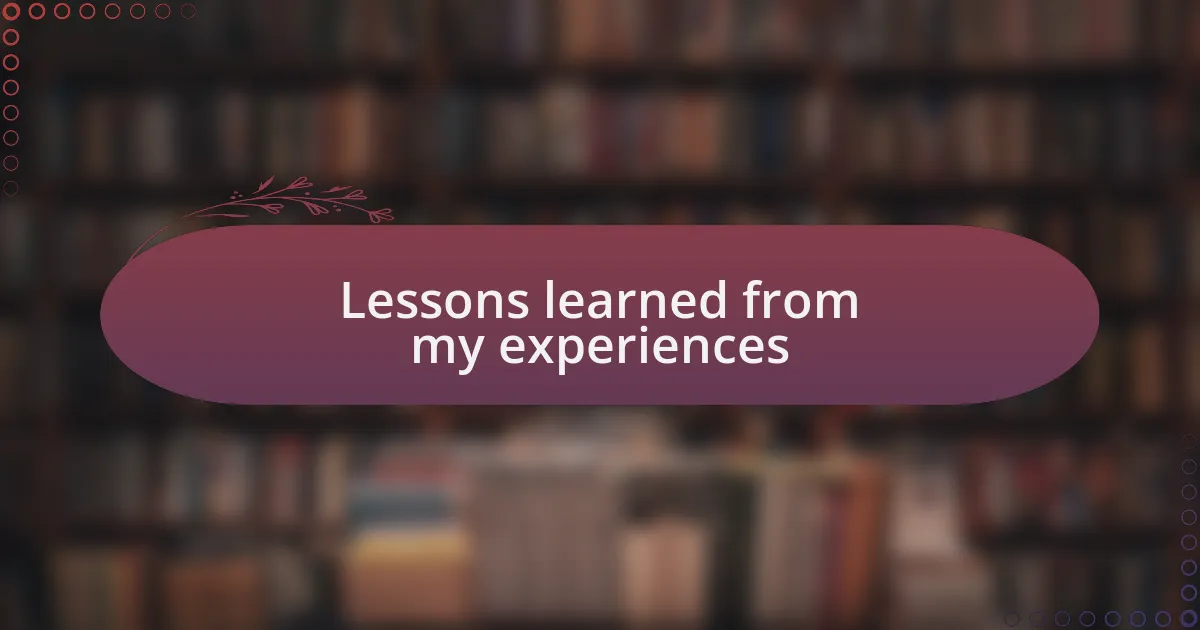
Lessons learned from my experiences
Reflecting on my experiences with student assessments, one lesson stands out: the power of feedback. Early on, I viewed assessments merely as a grading tool, but I soon learned that timely and constructive feedback could transform a student’s learning experience. Have you ever witnessed a student’s eyes light up when they finally grasp a challenging concept? It’s moments like these that remind me just how impactful our words can be.
Another key insight came from my attempts at creating a variety of assessment formats. I realized that standardized tests often didn’t capture the whole picture of a student’s abilities. I started incorporating project-based assessments, which allowed students to demonstrate their understanding in creative ways. I vividly remember watching a group of students present their science projects with such enthusiasm; it was clear they had understood the material deeply. Isn’t it incredible how different methods can unlock a student’s potential?
Lastly, I’ve discovered the significance of adaptability in assessment practices. Once, I conducted a quiz that didn’t go as planned; the questions were misaligned with what I had taught. Instead of feeling defeated, I saw it as an opportunity to re-evaluate my teaching methods. It prompted me to ask, how often do we need to pivot our approach to truly meet our students’ needs? Embracing this flexibility has not only improved my assessments but has also fostered a growth mindset within my classroom.